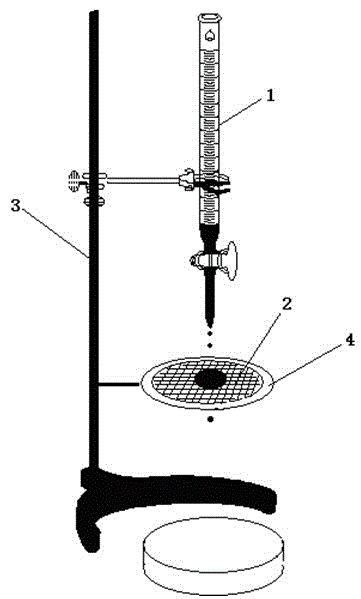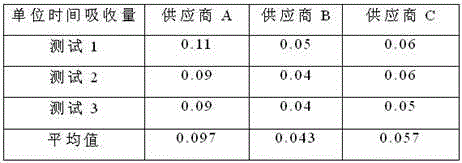[0003] At present, there are mainly the following methods for testing and evaluating the wettability of glass fiber cloth in the electronic grade glass fiber cloth and
copper clad laminate industry: (1) Sinking method: put a certain
viscosity of resin or glue in the container, and put a glass fiber cloth of standard size Place the sample horizontally above the liquid surface, and
record the time until the glass fiber cloth sample completely sinks; the
disadvantage is that the solvent volatilizes continuously during the test, and the
viscosity of the resin or glue increases gradually, resulting in a large change in the environmental conditions of the test. The end point of the test is judged by humans, and the error is large, which eventually leads to poor
repeatability of the test results
(2) Bullseye method: Draw a line similar to a target with a pencil on a white paper, place a standard size glass fiber cloth sample flat on the paper, drop a certain amount of resin or glue on the bullseye, and
record the appearance of the bullseye and the lines The time; its disadvantages: the transparency of the glass fiber cloth itself is different and the
diffusion speed of the glue or resin is slow, and it is difficult to determine the uniform standard for the
clarity of the displayed lines, resulting in inaccurate measurement results
Within the rated time, the more white stripes, the poorer the wettability; or the shorter the time required for complete
wetting, that is, the white stripes disappear completely, the better the wettability; the
disadvantage: the volatilization of the solvent during the experiment will affect The
viscosity of the resin or glue affects the test results. The resin or glue is greatly affected by the environment, so it is difficult to configure
standard test conditions and maintain fixed test conditions for a long time
The light
transmittance of the incompletely soaked glass fiber cloth is poor, and the light
transmittance of the fully soaked sample is good. The curve of the light
transmittance changing with time during the soaking process of the
test sample is obtained, and the data is converted into light transmittance data. Through testing and drawing This curve is used to analyze and compare the wettability characteristics of glass fiber cloth; its
disadvantage: the wettability between resin and glass fiber cloth cannot fully represent the wettability after the glue is configured with this resin; at the same time, because of the volatility of the solvent, the configuration The glue with basically the same viscosity is relatively difficult and time-consuming, and it is not suitable for rapid and large-scale use in the occasion of testing the wettability of glass fiber cloth
(5) Luminance
factor method of bonded sheet: In the Yxy
system of the
colorimeter, Y is the transparency factor, take the prepreg prepared after the glass fiber cloth is soaked in glue and baked,
cut it into a
standard test size, and measure it with the
colorimeter Y value, for the same type of glass fiber cloth and the same resin content, the smaller the Y value, the smaller the bubbles in it, and the better the wettability; its disadvantages: the difference in the measurement results of this method is not obvious, and it is affected by other factors. large; at the same time, this method is only applicable to
copper-clad laminate manufacturers, and does not take
advantage of the sampling and testing of fiberglass cloth manufacturers
(6)
Solvent penetration method:
Cut the glass fiber cloth into standard long
strip test size along the
latitude and
longitude direction, draw a line mark with a pencil along the width direction at the specified position at the lower end, and then clamp the two ends of the test strip with clips , hang vertically, immerse the lower end in a container filled with solvent until the liquid level is level with the mark, start timing, lift the sample from the liquid level after 1 minute and let it dry for 1 minute, immediately test and
record the height of the solvent penetration; its Disadvantages: The solvent cannot replace or represent the wettability between the actual glue and the glass fiber cloth, the correspondence is not good, and the test requires high squareness of the glass fiber cloth sample, and the warp and weft cuts have a great influence on the test results
[0004] To sum up, the existing test methods for glass fiber cloth can characterize the wettability of glass fiber cloth to a certain extent, but none of them can accurately measure the penetration degree of glass fiber cloth in the Z direction, that is, the completeness of glass fiber cloth cannot be measured. degree of penetration, therefore, the above-mentioned existing test methods cannot completely characterize the wettability of glass fiber cloth
 Login to View More
Login to View More  Login to View More
Login to View More 

